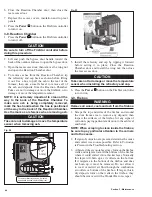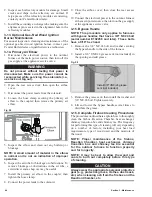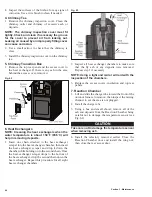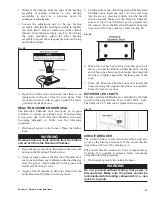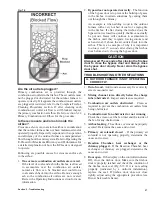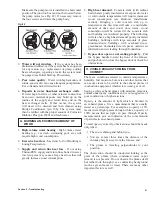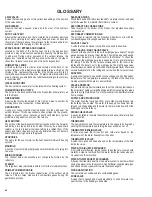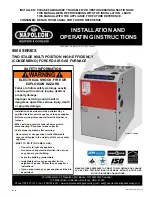
56
GENERAL TROUBLESHOOTING
INFORMATION
The E-Classic operates differently than other types
of wood-burning appliances. Understanding how the
E-Classic operates will help you to quickly identify
and solve many commonly asked questions. Be sure to
read thoroughly and understand Section 2 – Operating
Instructions.
If the outdoor furnace is not operating the way it should,
start by asking yourself the following questions before
continuing with more extensive troubleshooting.
Are the pieces of wood properly seasoned?
For the best results, it is best to burn seasoned wood for
the following reasons:
• The higher the moisture content of the wood being
burned, the less efficient the outdoor furnace
is, because it uses extra wood to evaporate the
moisture.
• The higher the moisture content of the wood being
burned, the harder it is to maintain the proper coal
bed because energy is required to heat the wood
and more slowly evaporate (boil off) the water.
• The larger the heat load on the outdoor furnace,
the drier the wood needs to be in order to maintain
an adequate coal bed.
By loading the smallest, driest pieces of wood in the
firebox first, it will help to dry out the wood loaded on
top of those pieces.
Is the coal bed the correct depth?
One to three inches (2.5 to 7.5 cm) of glowing coals are
needed to optimize the operation of the outdoor furnace.
If there is no coal bed, or if the coal bed is too shallow,
it may affect emissions. If the FireStar controller never
changes from Low Burn to High Burn (see FireStar
Controller section), it could be an indication that the
coal bed is inadequate.
If the coal bed is too deep, it could restrict air flow, the
coals will stop glowing, and Btu output will be lowered
(as shown in Fig. 75).
WARNING
Combustion air outlets must not be blocked or
covered by coals.
Fig. 75
Is the Reaction Chamber full of ash?
The Reaction Chamber is where final combustion
occurs. It is important that the Reaction Chamber
remain unobstructed to allow final combustion to occur.
It is not designed to be an ash collection area, although
over time ash may gradually accumulate in the Reaction
Chamber.
If ash builds up in the Reaction Chamber to a level that
obstructs flow (as shown in Fig. 76), the performance of
the outdoor furnace will be affected, so the ash must be
removed. A good rule is to clean the Reaction Chamber
before it becomes 1/3 full (approximately 3" or 7.5 cm
deep in any area of the Reaction Chamber).
SECTION 5 – TROUBLESHOOTING
Section 5 - Troubleshooting
Summary of Contents for e-Classic 1450 IR
Page 17: ...15 Section 1 Outdoor Furnace Installation...
Page 29: ...27 Section 1 Outdoor Furnace Installation Fig 30 Fig 31...
Page 30: ...28 Section 1 Outdoor Furnace Installation Fig 32 Fig 33...
Page 66: ...64 E CLASSIC 1450 WIRING DIAGRAM Section 6 General Information...
Page 67: ...65 Section 6 General Information E CLASSIC 1450 WIRING DIAGRAM OPTIONAL POWER IGNITION...
Page 69: ...67 NOTES...
Page 70: ...68 NOTES...
Page 71: ...69 NOTES...



